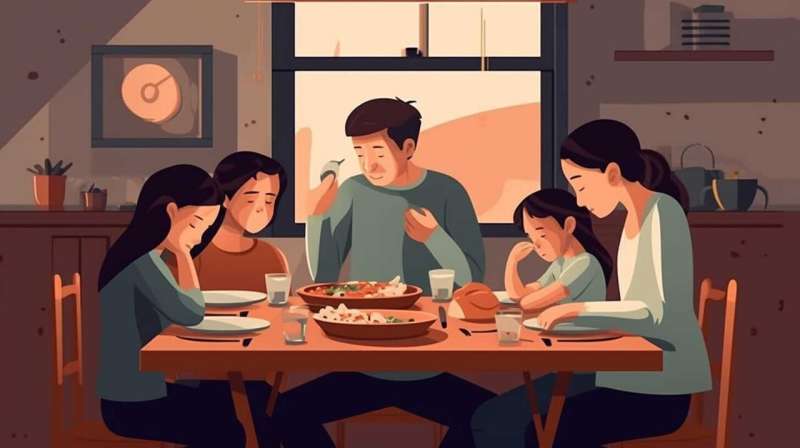This article has been reviewed according to Science X's editorial process and policies. Editors have highlighted the following attributes while ensuring the content's credibility:
fact-checked
peer-reviewed publication
trusted source
proofread
US families experience more chronic food insecurity now than 20 years ago, finds study

More families are chronically food insecure than they were 20 years ago, according to a study led by a University of Michigan researcher.
The finding comes at a time when SNAP and similar benefits may decrease because of the expected end of the federal Public Health Emergency for COVID-19.
The survey study, published as a research letter in JAMA Pediatrics, compared rates of food insecurity—defined by the U.S. Department of Agriculture as a lack of consistent access to enough food for every person in a household to live an active, healthy life—20 years apart
Using data that follows the same families over time, lead author and U-M researcher Noura Insolera found that the rate of families reporting chronic food insecurity between 2015 and 2019 more than doubled compared to families surveyed in 1999 to 2003.
"There are varying levels of being food insecure. These range from people being anxious about not having enough food, to the most severe, such as skipping meals or having their children skip meals, actually going without food," said Insolera, a research investigator in the Survey Research Center at the U-M Institute for Social Research.
"It's not just that there are more instances of having one wave of families saying they didn't have enough to eat, but that it actually persists wave after wave."
Previous research has shown that children who face food insecurity were more likely to have anxiety, depression, poorer diet quality, higher rates of diabetes and obesity, and lower academic performance, Insolera said. Conversely, kids who had access to SNAP (Supplemental Nutrition Assistance Program) and WIC (Women, Children & Infants) benefits were four times more likely to be food secure as adults compared to kids who had no access to those benefits.
In the study, Insolera looked at families who were surveyed in the Panel Study of Income Dynamics, a longitudinal study that follows the same families over time. She drew data from three waves of surveys that families completed from 1999 to 2003, then again from 2015 to 2019.
Nearly half of the 12.1% of families that ever reported food insecurity from 1999 to 2003 experienced at least one additional wave of food insecurity. From 2015 to 2019, 4.5% of all families reported chronic food insecurity (reports of food insecurity in all three waves). This doubles the rate of families who reported chronic food insecurity in the previous time period. At that time, 2.1% of families reported food insecurity over all three waves.
More low-income families with children reported chronic food insecurity in 2015 to 2019 compared to the previous time period as well. Nearly 11% of low-income families with children reported chronic food insecurity from 2015 to 2019 compared to 4.5% of all families and 4.8% of families with children during the same time period. Between 1999 and 2003, 8.8% of low-income families with children reported chronic food insecurity, while 2.1% of all families and 3.7% of all families with children reported the same.
"What I define as chronic food insecurity is over that four-year period, every time we ask, they are reporting to us that they are food insecure," Insolera said. "It was previously thought that this is sort of a fleeting thing, an acute problem: Someone loses a job and at some point, they experience food insecurity. But this is something that families are experiencing over and over again in a persistent way."
Being able to capture a single family's experience of poverty and food insecurity is a strength of the PSID, according to Insolera, while other similar, larger studies are helpful in giving a national estimate of food insecurity in a single snapshot.
"This is hopefully the beginning of our ability to look deeper and see what mechanisms are behind this chronic food insecurity," Insolera said. "We can look over time at families in general, and see that they are doing worse—so why don't we help families so they can do better in the future?"
More information: Noura Insolera, Chronic Food Insecurity in US Families With Children, JAMA Pediatrics (2023). DOI: 10.1001/jamapediatrics.2022.5820





















